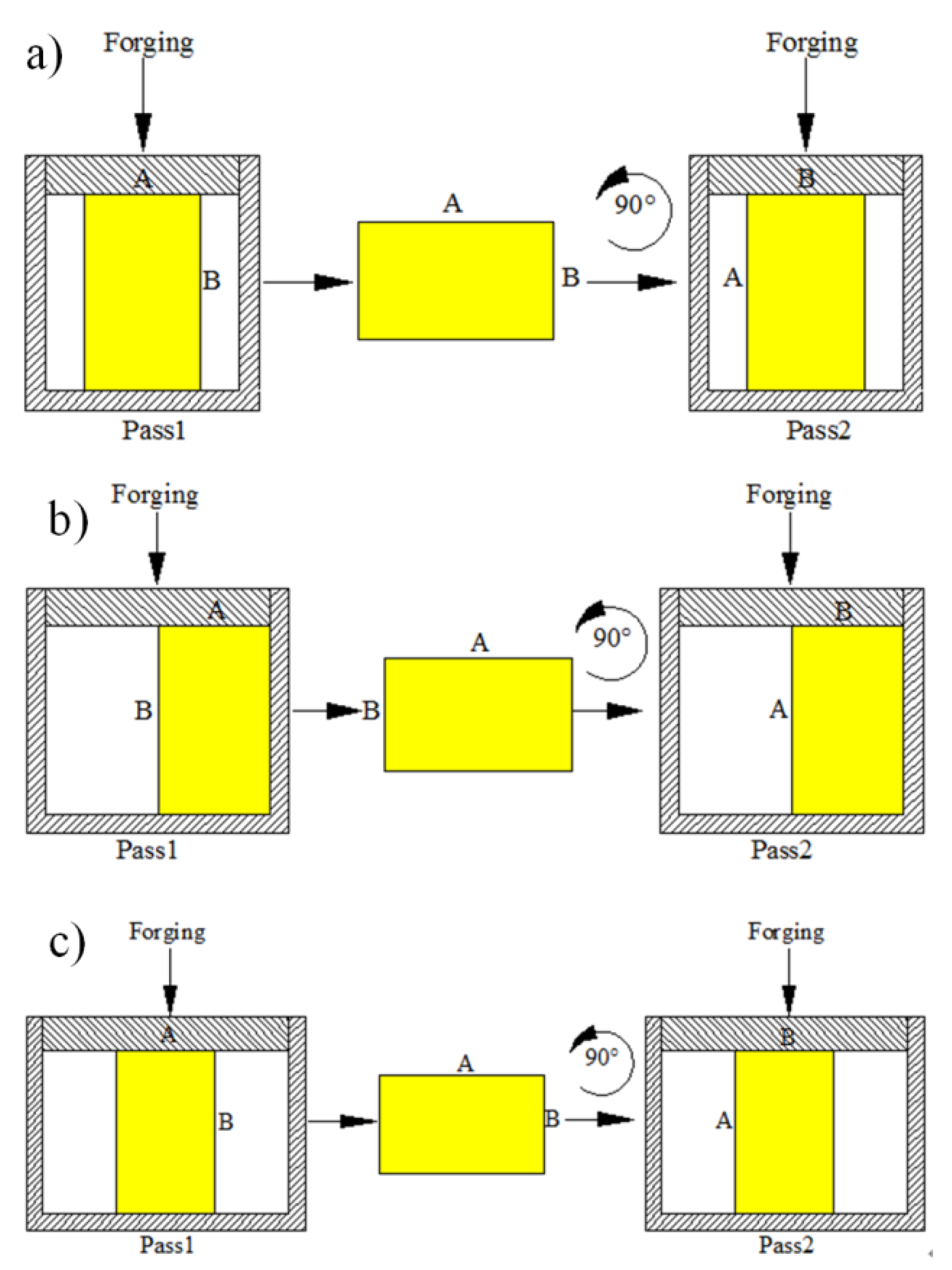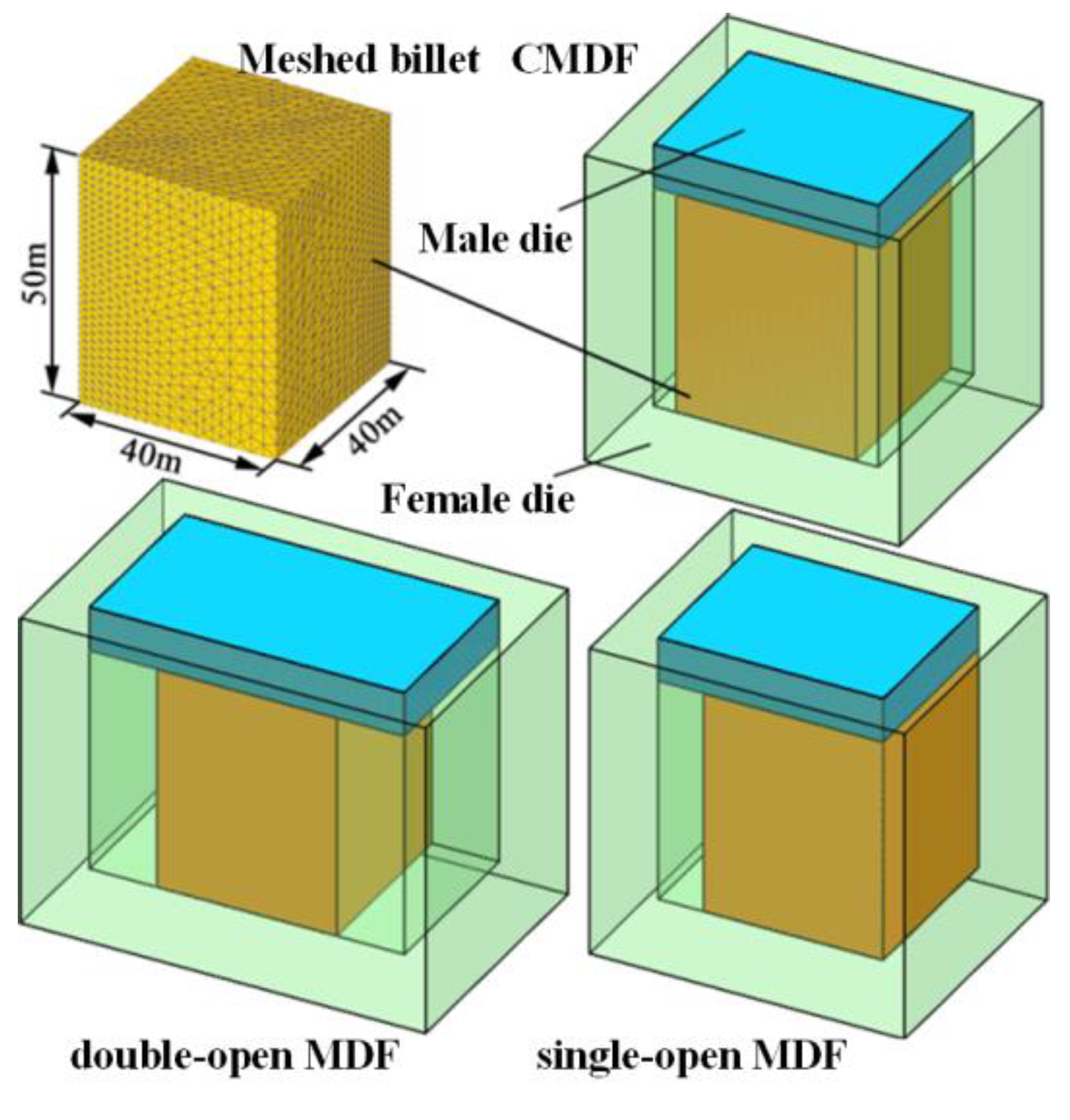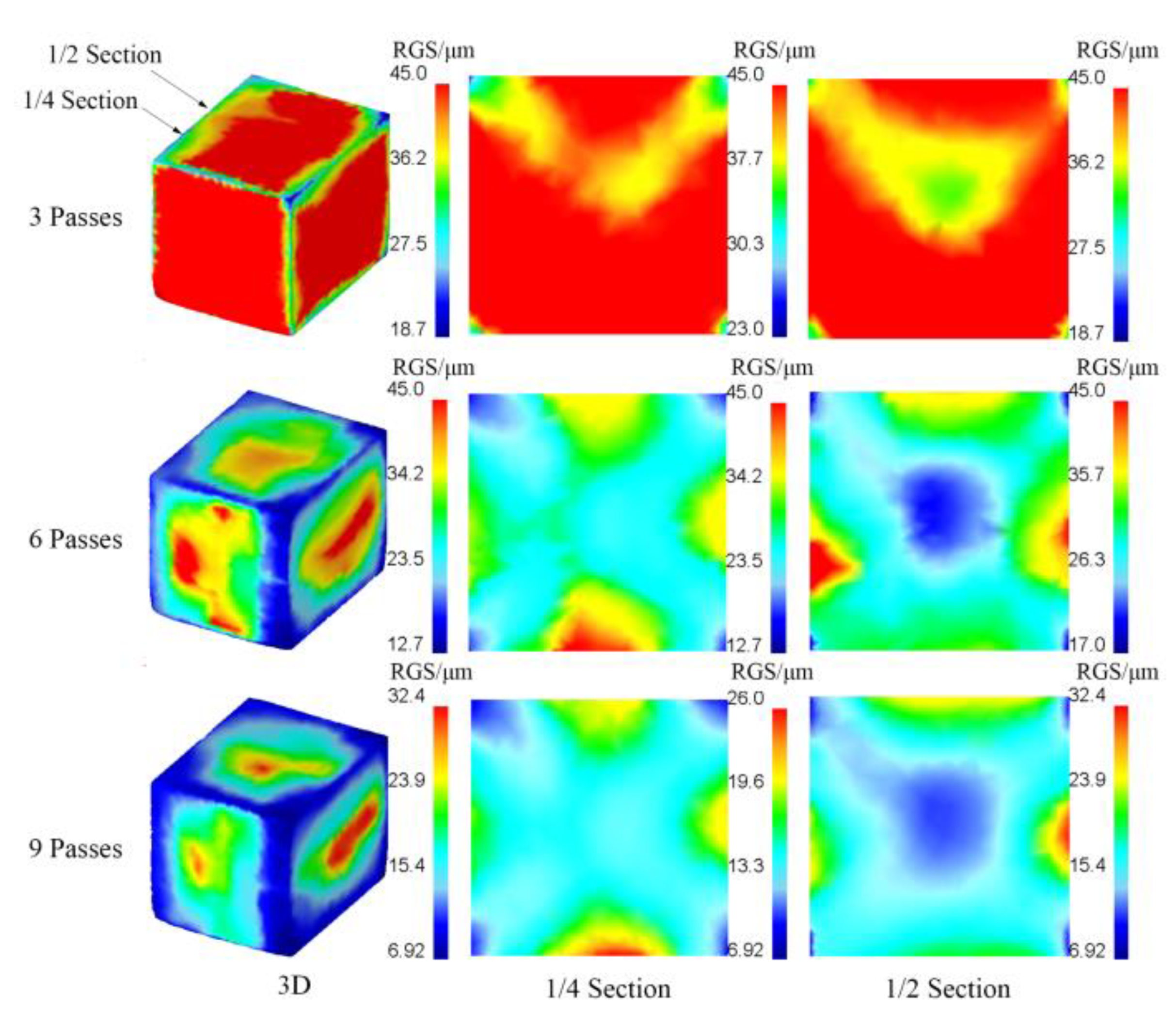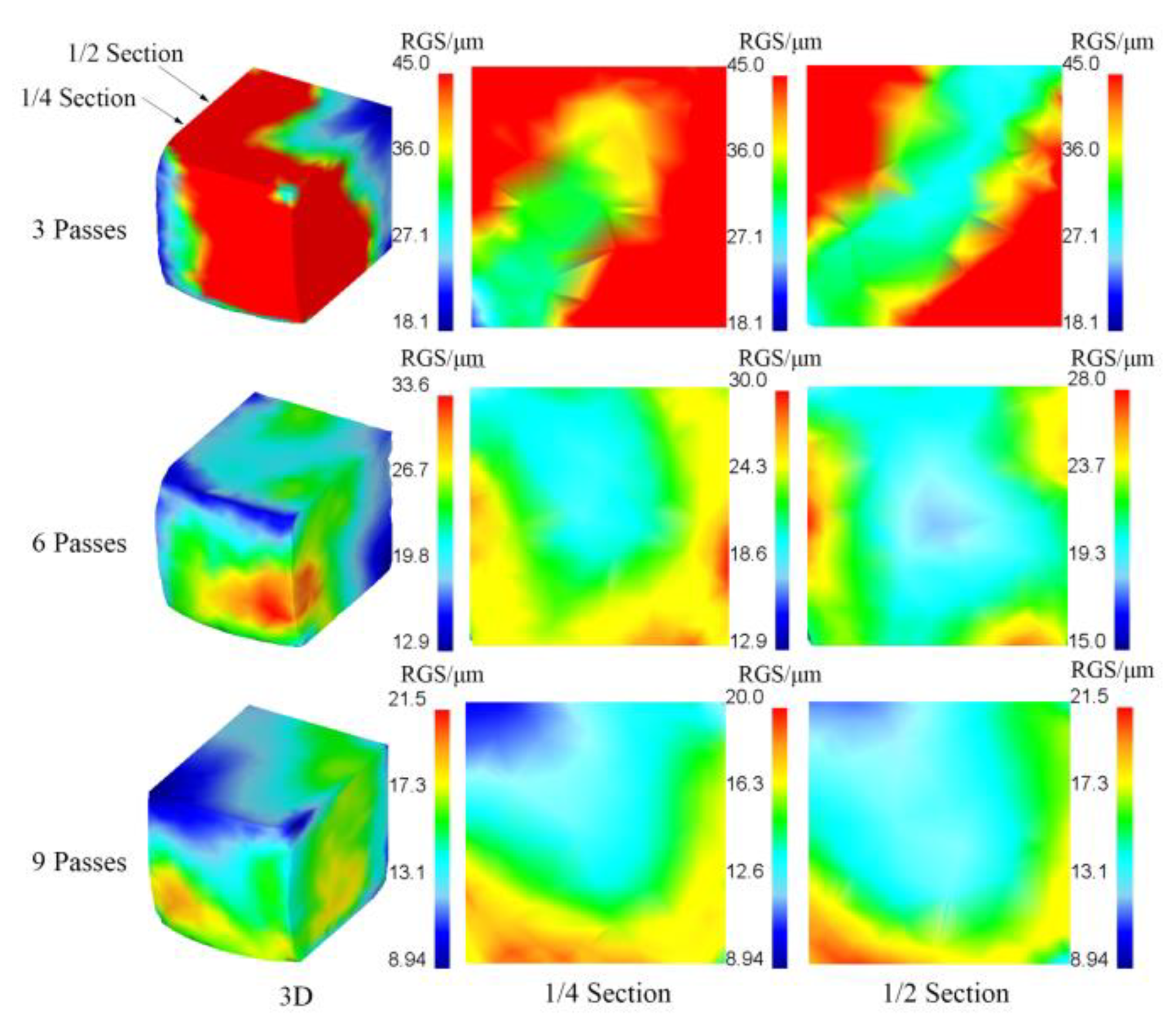Constitutive Model and Microstructure Evolution Finite Element Simulation of Multidirectional Forging for GH4169 Superalloy
Abstract
1. Introduction
2. Multidirectional Forging and Finite Element Modeling
2.1. Multidirectional Forging Process
2.2. Constitutive Equation and Deform-3D Software Secondary Development
2.3. Establishment of Finite Element Model
3. Analysis and Discussion of Simulation Results
3.1. Variation of Internal Grain Size of Forgings Under Different Conditions
3.2. Microstructure Changes of Forgings Under Different Conditions
3.3. Inhomogeneity of Forgings
4. Conclusions
Author Contributions
Funding
Conflicts of Interest
References
- Zeng, Q.R.; Liu, G.; Liu, L.; Qin, Y. Investigation into grindability of a superalloy and effects of grinding parameters on its surface integrity. Proc. Inst. Mech. Eng. Part B 2015, 229, 238–250. [Google Scholar] [CrossRef]
- Du, J.H.; Lu, X.D.; Deng, Q. Effect of heat treatment on microstructure and mechanical properties of GH4169 superalloy. Rare Metal Mat. Eng. 2014, 43, 1830–1834. [Google Scholar] [CrossRef]
- Lu, X.D.; Du, J.H.; Deng, Q. High temperature structure stability of GH4169 superalloy. Mater. Sci. Eng. A 2013, 559, 623–628. [Google Scholar] [CrossRef]
- Liu, F.C.; Lin, X.; Zhao, W.W.; Zhao, X.M.; Chen, J.; Huang, W.D. Effects of solution treatment temperature on microstructures and properties of laser solid forming GH4169 superalloy. Rare Metal Mat. Eng. 2010, 39, 1519–1524. [Google Scholar]
- Na, Y.S.; Yeom, J.T.; Park, N.K.; Lee, J.Y. Simulation of microstructures for Alloy 718 blade forging using 3D FEM simulator. J. Mater. Process. Technol. 2003, 141, 337–342. [Google Scholar] [CrossRef]
- Li, H.Y.; Kong, Y.H.; Chen, G.S.; Xie, L.X.; Zhu, S.G.; Sheng, X. Effect of different processing technologies and heat treatments on the microstructure and creep behavior of GH4169 superalloy. Mater. Sci. Eng. A 2013, 582, 368–373. [Google Scholar] [CrossRef]
- Ansarian, I.; Shaeri, M.H.; Ebrahimi, M.; Minarik, P.; Bartha, K. Microstructure evolution and mechanical behaviour of severely deformed pure titanium through multi directional forging. J. Alloys Compd. 2019, 776, 83–95. [Google Scholar] [CrossRef]
- Thomas, A.; El-Wahabi, M.; Cabrera, J.M.; Prado, J.M. High temperature deformation of Inconel 718. J. Mater. Process. Technol. 2006, 177, 469–472. [Google Scholar] [CrossRef]
- Hu, J.P.; Zhuang, J.Y.; Zhong, Z.Y.; Janschek, P.; Kramer, J. Study on constitutive equation of alloy IN718 in hammer forging process. In Proceedings of the 5th International Symposium on Superalloys 718, 625, 706 and Various Derivatives, Pittsburgh, PA, USA, 17–20 June 2001; pp. 229–236. [Google Scholar]
- Dandre, C.A.; Roberts, S.M.; Evans, R.W.; Reed, R.C. Microstructural evolution of Inconel* 718 during ingot breakdown: Process modelling and validation. Mater. Sci. Technol. 2000, 16, 14–25. [Google Scholar] [CrossRef]
- Tin, S.; Lee, P.D.; Kermanpur, A.; Rist, M.; Mclean, M. Integrated modeling for the manufacture of Ni-based superalloy discs from solidification to final heat treatment. Metall. Mater. Trans. A 2005, 36, 2493–2504. [Google Scholar] [CrossRef]
- Miura, H.; Maruoka, T.; Yang, X.; Jonas, J.J. Microstructure and mechanical properties of multi-directionally forged Mg–Al–Zn alloy. Scr. Mater. 2012, 66, 49–51. [Google Scholar] [CrossRef]
- Miura, H.; Yu, G.; Yang, X. Multi-directional forging of AZ61Mg alloy under decreasing temperature conditions and improvement of its mechanical properties. Mater. Sci. Eng. A 2011, 528, 6981–6992. [Google Scholar] [CrossRef]
- Guo, Q.; Yan, H.G.; Chen, Z.H.; Zhang, H. Grain refinement in as-cast AZ80 Mg alloy under large strain deformation. Mater. Charact. 2007, 58, 162–167. [Google Scholar] [CrossRef]
- Kishchik, M.S.; Mikhaylovskaya, A.V.; Kotov, A.D.; Mosleh, A.O.; AbuShanab, W.S.; Portnoy, V.K. Effect of multidirectional forging on the grain structure and mechanical properties of the Al–Mg–Mn alloy. Materials 2018, 11, 2166. [Google Scholar] [CrossRef] [PubMed]
- Xing, J.; Soda, H.; Yang, X.Y.; Miura, H.; Sakai, T. Ultra-Fine Grain Development in an AZ31 Magnesium Alloy during Multi-Directional Forging under Decreasing Temperature Conditions. Mater. Trans. 2005, 46, 1646–1650. [Google Scholar] [CrossRef]
- Konovalov, S.; Chen, X.Z.; Sarychev, V.; Nevskii, S.; Gromov, V.; Trtica, M. Mathematical modeling of the concentrated energy flow effect on metallic materials. Metals 2016, 7, 4. [Google Scholar] [CrossRef]
- Zafari, A.; Ding, Y.P.; Cui, J.Z.; Xia, K.N. Achieving fine beta grain structure in a metastable beta titanium alloy through multiple forging-Annealing cycles. Metall. Mater. Trans. A 2016, 47, 3633–3648. [Google Scholar] [CrossRef]
- Jin, Y.B.; Xue, H.; Yang, Z.Y.; Zhang, L.L.; Zhang, C.X.; Wang, S.R.; Luo, J.T. Constitutive equation of GH4169 superalloy and microstructure evolution simulation of double-open multidirectional forging. Metals 2019, 9, 1146. [Google Scholar] [CrossRef]
- Kermanpur, A.; Tin, S.; Lee, P.D.; Mclean, M. Integrated modeling for the manufacture of aerospace discs: Grain structure evolution. JOM 2004, 56, 72–78. [Google Scholar] [CrossRef][Green Version]
- Park, N.K.; Kim, I.S.; Na, Y.S.; Yeom, J.T. Hot forging of a nickel-base superalloy. J. Mater. Process. Technol. 2001, 111, 98–102. [Google Scholar] [CrossRef]
- Murty, S.V.S.N.; Rao, B.N. On the development of instability criteria during hotworking with reference to IN 718. Mater. Sci. Eng. A 1998, 254, 76–82. [Google Scholar] [CrossRef]
- Chen, X.M.; Lin, Y.C.; Li, X.H.; Chen, M.S.; Yuan, W.Q. Investigation on strain dependence of metadynamic recrystallization behaviors of GH4169 superalloy. Vacuum 2018, 149, 1–11. [Google Scholar] [CrossRef]











| Process Parameters | Symbol | Unit | Value |
|---|---|---|---|
| Forging size | - | mm | 40 × 40 × 50 |
| Mold material | - | - | H13 |
| Forging temperature | T | °C | 800–1000 |
| Coefficient of friction | f | - | 0.3 |
| Thermal conductivity | λ | W/(m·K) | 20−40 |
| Specific heat | C | N/(mm2·K) | 3.0–5.0 |
| Initial grain size | d | μm | 45 |
| Upper die size | - | mm | 50 × 40 × 10 |
| Lower die size | - | mm | 70 × 60 × 60 |
| Compression rate | - | % | 20 |
| Process | Temperature/°C | Pass | Cb | Cd | Ct |
|---|---|---|---|---|---|
| CMDF | 800 | 3 | 0.80 | 0.23 | 0.87 |
| 6 | 0.80 | 0.83 | 0.79 | ||
| 9 | 0.79 | 1.20 | 0.65 | ||
| 900 | 3 | 0.75 | 0.34 | 0.85 | |
| 6 | 0.74 | 0.74 | 0.88 | ||
| 9 | 0.72 | 0.10 | 0.96 | ||
| 1000 | 3 | 0.67 | 0.35 | 0.86 | |
| 6 | 0.67 | 0.22 | 0.92 | ||
| 9 | 0.67 | 0.27 | 0.90 | ||
| single-open MDF | 800 | 3 | 0.39 | 0.42 | 0.79 |
| 6 | 0.46 | 0.44 | 0.78 | ||
| 9 | 0.24 | 0.31 | 0.88 | ||
| 900 | 3 | 0.32 | 0.129 | 0.82 | |
| 6 | 0.42 | 0.10 | 0.83 | ||
| 9 | 0.55 | 0.14 | 0.81 | ||
| 1000 | 3 | 0.31 | 0.09 | 0.89 | |
| 6 | 0.37 | 0.02 | 0.96 | ||
| 9 | 0.29 | 0.07 | 0.93 | ||
| double-open MDF | 800 | 3 | 0.74 | 0.08 | 0.99 |
| 6 | 0.70 | 0.88 | 0.96 | ||
| 9 | 0.61 | 1.14 | 0.95 | ||
| 900 | 3 | 0.72 | 0.23 | 0.97 | |
| 6 | 0.75 | 0.46 | 0.96 | ||
| 9 | 0.60 | 0.22 | 0.97 | ||
| 1000 | 3 | 1.29 | 0.67 | 0.98 | |
| 6 | 0.86 | 0.75 | 0.97 | ||
| 9 | 0.81 | 0.71 | 0.97 |
Publisher’s Note: MDPI stays neutral with regard to jurisdictional claims in published maps and institutional affiliations. |
© 2020 by the authors. Licensee MDPI, Basel, Switzerland. This article is an open access article distributed under the terms and conditions of the Creative Commons Attribution (CC BY) license (http://creativecommons.org/licenses/by/4.0/).
Share and Cite
Jin, Y.; Xi, C.; Xue, P.; Zhang, C.; Wang, S.; Luo, J. Constitutive Model and Microstructure Evolution Finite Element Simulation of Multidirectional Forging for GH4169 Superalloy. Metals 2020, 10, 1695. https://doi.org/10.3390/met10121695
Jin Y, Xi C, Xue P, Zhang C, Wang S, Luo J. Constitutive Model and Microstructure Evolution Finite Element Simulation of Multidirectional Forging for GH4169 Superalloy. Metals. 2020; 10(12):1695. https://doi.org/10.3390/met10121695
Chicago/Turabian StyleJin, Yongbo, Chenyang Xi, Peng Xue, Chunxiang Zhang, Sirui Wang, and Junting Luo. 2020. "Constitutive Model and Microstructure Evolution Finite Element Simulation of Multidirectional Forging for GH4169 Superalloy" Metals 10, no. 12: 1695. https://doi.org/10.3390/met10121695
APA StyleJin, Y., Xi, C., Xue, P., Zhang, C., Wang, S., & Luo, J. (2020). Constitutive Model and Microstructure Evolution Finite Element Simulation of Multidirectional Forging for GH4169 Superalloy. Metals, 10(12), 1695. https://doi.org/10.3390/met10121695




